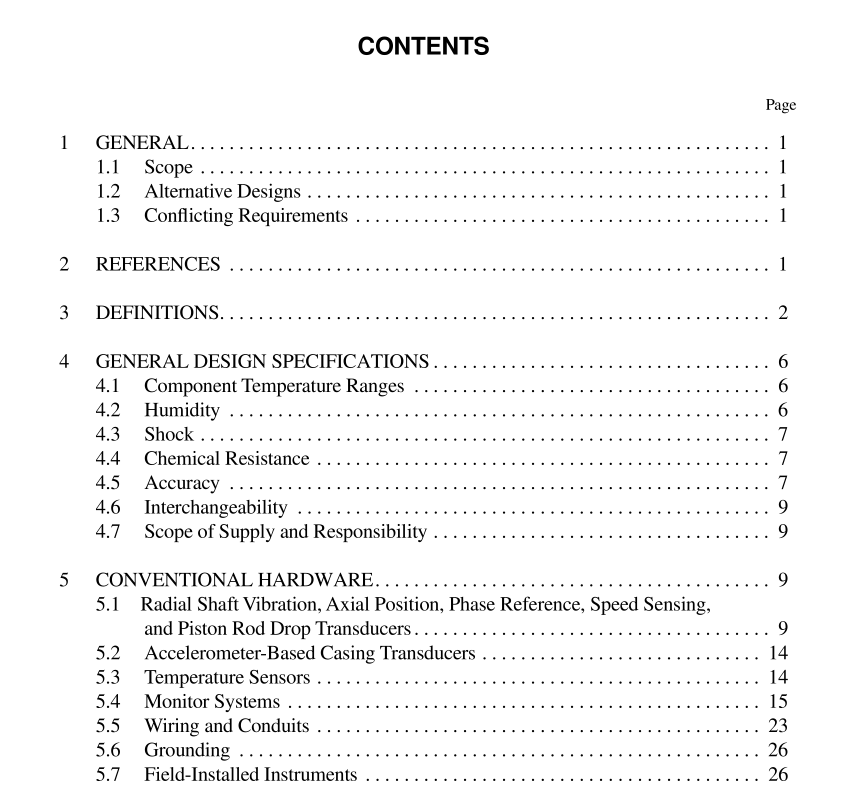API STD 670 pdf download

API STD 670 pdf download.Machinery Protection Systems
3 Definitions
Terms used in this standard are defined as follows: 3.1 accelerometer: A piezoelectric sensor containing inte- gral amplification with an output proportional to acceleration. 3.2 accelerometer cable: An assembly consisting of a specified length of cable and mating connectors. Both the cable and the connectors must be compatible with the particu- lar accelerometer and (when used) intermediate termination. 3.3 accuracy: The degree of conformity of an indicated value to a recognized accepted standard value or ideal value. 3.4 active magnetic speed sensor: A magnetic speed sensor that requires external power and provides a conditioned (that is, square wave) output. Typical excitation is between +5 to +30 Vdc. 3.5 active (normal) thrust direction: The direction of a rotor axial thrust load expected by the machinery vendor when the machinery is operating under normal running conditions. 3.6 alarm (alert) setpoint: A preset value of a parameter at which an alarm is activated to warn of a condition that requires corrective action. 3.7 alarm/shutdown/integrity logic: The function of a monitor system whereby the outputs of the signal processing circuitry are compared against alarm or shutdown setpoints and circuit fault criteria. Violations of these setpoints or cir- cuit fault criteria result in alarm or shutdown status conditions in the monitor system. These status conditions may be sub- jected to preset time delays or logical voting with other status conditions, and are then used to drive the system output relays and status indicators and outputs. 3.8 bench test: A factory acceptance test performed within the testing range (see 4.1 and Table 1). 3.9 best fit straight line: The line drawn through the actual calibration curve where the maximum plus or minus deviations are minimized and made equal.3.10 blind monitor system: Does not contain an integral display. A blind monitor system is permitted as a “when speci- fied” option of this standard provided it is supplied with at least one dedicated, continuous, non-integral display. The blind monitor provides certain minimal integral status indica- tion independently of any non-integral displays (see 5.4.1.6.b). 3.11 buffered output: An unaltered, analog replica of the transducer input signal that preserves amplitude, phase, fre- quency content, and signal polarity. It is designed to prevent a short circuit of this output to monitor system ground from affecting the operation of the machinery protection system. The purpose of this output is to allow connection of vibration analyzers, oscilloscopes, and other test instrumentation to the transducer signals. 3.12 channel: The monitor system components associ- ated with a single transducer. The number of channels in a monitor system refers to the number of transducer systems it can accept as inputs. 3.13 channel pair: Two associated measurement loca- tions (such as the X and Y proximity probes at a particular radial bearing or the two axial proximity probes at a particular thrust bearing). 3.14 circuit fault: A machinery protection system circuit failure that adversely affects the function of the system.3.15 construction agency: The contractor that installs the machinery train or its associated machinery protection system. 3.16 contiguous: Mechanically connected and included in the same housing or rack containing the signal processing and alarm/shutdown/integrity logic functions of the monitor system. Note: Installation of all monitor system components in the same panel or cabinet is not the same as contiguous. 3.17 continuous display: Simultaneous, uninterrupted indication of all status conditions and measured variables in the machinery protection system as required by this standard. It also continuously updates this indication at a rate meeting or exceeding the requirements of this standard. 3.18 controlled access: A security feature of a machin- ery protection system that restricts alteration of a parameter to authorized individuals. Access may be restricted by means such as the use of a key or coded password or other proce- dures requiring specialized knowledge. 3.19 dedicated display: A display which indicates only those parameters from its associated machinery protection system(s) and is not shared with or used to indicate informa- tion from other systems such as process controllers, logic controllers, turbine controllers, and so forth. 3.20 display: An analog meter movement, cathode ray tube, liquid crystal device, or other means for visually indi- cating the measured variables and status conditions from the machinery protection system. A display may be further classi- fied as integral or non-integral, dedicated or shared, continu- ous or non-continuous. 3.21 dual path: A configuration of the monitor system such that the same transducer system is used as an input to two separate channels in the monitor system, and different signal processing (such as filtering or integration) is applied to each channel.









